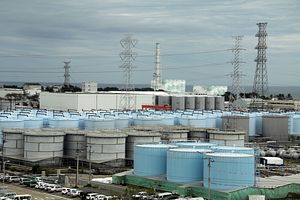Eight years since the Fukushima Tokyo Electric Power Company (TEPCO) nuclear power plant suffered a tsunami-triggered triple meltdown in 2011, space to store 1 million tons of radioactive water used to cool the destroyed reactors is running out.
TEPCO and the government are considering options for the release of 900 storage tanks of radioactive waste currently accumulating at the power plant that will reach capacity by summer 2022. It is not clear how much water would need to be dumped into the ocean, but the current suggestion mulls a controlled release once storage space runs out.
In a news briefing, outgoing environment minister Yoshiaki Harada said there wasn’t any choice other than to dilute the toxic water into the ocean calling it the only “realistic option.” Ichiro Matsui, the mayor of Osaka, backed the position. He said he would be willing to accept the water into Osaka bay if the government’s policy is proven to be scientifically safe to humans.
TEPCO adopts a decontamination method called “Advanced Liquid Processing System” (ALPS) which is capable of removing almost all radioactive elements. But it isn’t advanced enough to filter out tritium – a radioactive isotope of hydrogen regarded by the government as relatively “low risk” to humans.
The controversial announcement has sparked fierce backlash from local fishermen fearing the impacts of fish stocks and ocean health. The Osaka Prefectural Fisheries Cooperative Association submitted a letter of protest to Osaka prefecture condemning the mayor’s remarks, citing immeasurable damage to Japan’s fishing reputation.
The popularity of Fukushima seafood took a blow following the triple nuclear meltdown and Japan has steadily challenged governments at the WTO to remove strict import bans on Japanese seafood. Japan regards South Korean restrictions to be the toughest.
The latest spat isn’t helping Japan’s dismal trade relationship with South Korea. A quarrel between Japan and South Korean officials played out at a general meeting at the International Atomic Energy Agency in Vienna. Japan’s Minister for Science and Technology Naokazu Takemoto, although avoiding naming South Korea, stated “some criticisms are not based on facts or scientific grounds.” In retaliation, South Korean Vice Science Minister Mun Miock stressed “anxiety is spreading all over the world” and that it was “not only a Japanese issue but an international one that could affect the global marine environment.”
The proposed measures have sent South Korea into a panic. In an effort to address public concern over Fukushima’s radioactive water, a Japanese diplomat in Seoul was summoned last month for an explanation. Harada, the outgoing environment minister, aggravated South Korea adding “the most important thing for Japan to do is provide sincere explanations to countries that oppose Tokyo’s policies.”
While nuclear plants on the coast are known to dump “treated” water laced with tritium into the sea, last year TEPCO admitted that water still contains other radioactive materials beyond legally permitted levels. Environmental groups such as Greenpeace warn the accumulation of radioactive elements could be absorbed by shellfish and in the bones of small fish.
A final disposal method of purifying the contaminated water is being examined by a government subcommittee of experts. So far the subcommittee has considered six disposal methods including geological injections, and evaporation also adding long term storage as an option.
Prime Minister Shinzo Abe’s cabinet reshuffle last week introduced Shinjiro Koizumi, 38, as the new minister of environment and minister for nuclear emergency preparedness in his first role as a cabinet member. Since taking up the post last week, Koizumi has not indicated how he would handle the dispute.

































